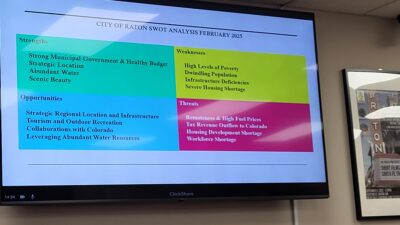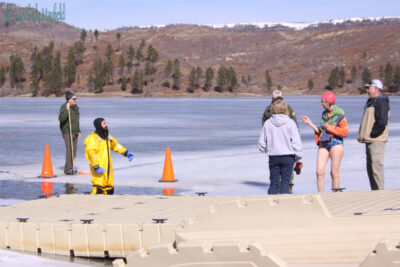ALBUQUERQUE – New Mexico Wild is celebrating the reintroduction of federal legislation aimed at protecting lands in the greater Chaco region. Senators Tom Udall and Martin Heinrich have introduced the Chaco Cultural Heritage Area Protection Act of 2019, while Representatives Ben Ray Lujan, Deb Haaland, and Xochitl Torres Small have introduced a House version of the same legislation.
“Many Chacoan sites exist outside the Park’s official boundaries, so lease sales by BLM in the surrounding area almost always mean the loss of artifacts, history, and sacred sites as well as wildlands, habitat and dark skies. This bill represents a major step forward toward permanently protecting the area’s rich cultural heritage, world-class archaeological resources and sensitive natural landscape. We are proud to stand in solidarity with the All Pueblo Council of Governors and the Navajo Nation supporting this legislation. New Mexico’s entire federal delegation acting in concert sends an unmistakable message that this serious threat requires a serious response,” said Mark Allison, Executive Director of New Mexico Wild.
On May 22, 2018, Sens. Tom Udall and Martin Heinrich introduced an initial piece of legislation to protect the area surrounding Chaco Culture National Historical Park, a UNESCO World Heritage Site, which has been subjected to rampant oil and gas development for many decades. The areas immediately surrounding the park are some of the only places in the San Juan Basin that remain relatively undeveloped.
The bill that was introduced today is an updated version of the 2018 legislation. If it passes, no additional land managed by the Bureau of Land Management within ten miles of the park and certain significant outlying sites could ever be leased for mineral extraction. In addition, the legislation would permanently withdraw 325,075 acres of oil, natural gas, coal and other minerals owned by the U.S. Federal Government. Existing federal mineral leases as well future leases of state, tribal, and allottee minerals would not be impacted by this withdrawal. See map: Proposed Chaco Protection Zone.
Earlier this year, the Bureau of Land Management (BLM) removed approximately 1,500 acres of land in the areas adjacent to Chaco Culture National Historical Park from an oil and gas lease sale after significant public outcry from local communities, tribes, and conservation organizations. The BLM made a similar decision in early 2018, temporarily deferring an oil and gas lease sale after facing immense public backlash for initially including parcels of land near Chaco in the sale.
The Chaco protection bill remedies the problem by permanently removing these parcels from the BLM’s consideration. Chaco and its surrounding areas are sacred to both the Navajo Nation and the pueblos of the Southwest. It contains myriad archaeological sites, including entire structures from thousands of years ago. It is still used today for religious ceremonies, and attracts visitors from all over the world, greatly contributing to the local economy.
“Despite outcries from local communities, tribes, and conservation organizations, the Bureau of Land Management continues to allow oil and gas companies to lease parcels near sacred sites and the boundary of the park itself,” said Judy Calman, Staff Attorney for New Mexico Wild. “Parcels slated for the March lease sale were deferred, but only after immense public outcry. This Administration seems determined to lease as much public land for mineral extraction as it can, which is why we are very encouraged our Congressional leaders are taking action.”
On March 21, 2019, the Navajo Nation and the All Pueblo Council of Governors (APCG) came together for a historic summit to declare their shared commitment to permanently protect the lands in the greater Chaco region. It was only the third meeting of its kind between the two bodies in the more than 400-year history of the APCG, with each meeting focusing on the need to protect Chaco and the surrounding areas.
The Chaco Cultural Heritage Area Protection Act of 2019 is supported by Navajo Nation, All Pueblo Council of Governors, New Mexico Wild, the Wilderness Society, and Southwest Native Cultures. A 2018 resolution in support of the original legislation from APCG can be found HERE.
Quotes from tribal leaders and members of New Mexico’s Congressional Delegation:
“For our people, the Greater Chaco landscape is considered a living cultural site. Our spiritual leaders continue to make pilgrimages to this pristine landscape and our communities consider these sites to be ‘the footprints of our ancestors’. Despite its sacred importance, Chaco is constantly threatened by a growing network of roads, oil pads and derricks. But by working with our fellow tribal nations, the state of New Mexico and our federal delegation we have the chance to protect Chaco once and for all. We recognize the great contributions Senator Udall, Senator Heinrich, Congressman Lujan, Congresswoman Haaland and Congresswoman Torres-Small have made to preserving our ancestral homeland with these two bills and call on others to take up this cause. We must protect Chaco, and together we will.”
– E. Paul Torres, Chairman, All Pueblo Council of Governors
“For a millennia our people have maintained a strong connection to Chaco, Mesa Verde, Bears Ears and other cultural sites in the southwest. In the Greater Chaco region we are able to connect to our history, our ancestors, and also to our future as Pueblo people. The collective wisdom of generations continues to be passed down in our tribal communities through language and culture. The wisdom and teachings of our predecessors hold that we must be caretakers and of these sacred places and the entire natural world. We are proud to continue the traditions of our ancestors by protecting Chaco and look forward to the day when these vital cultural resources are permanently protected. These two pieces of legislation are a strong first step towards conserving the historic, cultural landscape we call home.”
– Brian Vallo, Governor, Pueblo of Acoma
“The greater Chaco region is a New Mexico treasure. Many Tribes and Pueblos in Northern New Mexico can trace their ancestry and culture to Chaco, and consider these sites sacred. But even as archeologists are making exciting new discoveries about this region – and even as Tribes and the American public speak out in overwhelming support of protecting this precious landscape – Chaco is being threatened by expanding energy development, including recently proposed leasing inside this long-standing buffer zone. I am proud of my work with New Mexico’s Pueblos and the Navajo Nation to craft this bill to provide a fundamental baseline of protection for this sacred, archaeological wonder. This legislation honors New Mexico’s history and culture, recognizing that some places are just too special to lose.”
– Senator Tom Udall
“The Chaco region holds deep meaning to New Mexico’s Pueblos, whose history and traditional knowledge live on in its thousands of ancestral sites, and to the Navajo Nation, whose lands and communities surround Chaco Culture National Historical Park. I’m proud to introduce legislation to protect the landscape nearest to the existing Park from federal mineral development. While we plan for any future energy development in the San Juan Basin, protecting these sites is something we should all be able to agree on. This is about listening to tribal leaders and all of the New Mexicans who are calling on us to preserve the integrity of Chaco’s irreplaceable resources. I will keep doing all I can to defend important cultural and religious sites and the sacred landscape of the greater Chaco region for future generations.”
– Senator Martin Heinrich
“This effort will preserve the greater Chaco region for generations to come. Chaco Canyon is sacred land that has been home to some of the most resilient communities in history, and it is our responsibility to protect against efforts that would destroy the legacy of the Chacoan people and other indigenous communities or harm these beautiful public lands. We must do everything possible to defend the greater Chaco area by halting future oil and gas development in the area, and I’m proud to support legislation that will further address the environmental, health, economic, and cultural needs of this region.”
-Assistant Speaker, Congressman Ben Ray Lujan
It’s important that we protect Chaco Canyon, both because it is a sacred place that should be valued the same way we value other sacred places, but also because public lands must be protected. However, time and again this special place has been put up to be exploited by big oil companies. By introducing these protections we’re going beyond protecting a beautiful piece of New Mexico, we’re recognizing the significance Chaco holds for the Native American community and to all New Mexicans. By keeping Chaco from being destroyed by the fossil fuel industry, future generations will have access to this special place.”
-Congresswoman Deb Haaland
“I am proud to introduce the Chaco Cultural Heritage Area Protection Act along with the rest of the New Mexico delegation. It is the result of years of hard work and collaboration between New Mexico’s Congressional delegation, tribal leadership, and other stakeholders that will ensure Chaco Canyon and its sacred lands are protected for generations to come. Moving forward, it is critical that we continue to work together with tribal communities to honor our trust responsibility and protect sacred, ancestral lands like Chaco Canyon.”
– Congresswoman Xochitl Torres Small
###
ABOUT THE NEW MEXICO WILDERNESS ALLIANCE: The New Mexico Wilderness Alliance or “New Mexico Wild” is a non-profit 501 (C)(3), independent, homegrown, grassroots, conservation organization dedicated to the protection, restoration and continued respect of New Mexico’s wildlands and Wilderness areas. With staff and thousands of supporters throughout the state, New Mexico Wild is dedicated to the rights and the value of citizen involvement in protecting increasingly rare wild places within public lands. Just as freedom is every American’s birthright so too is Wilderness.





